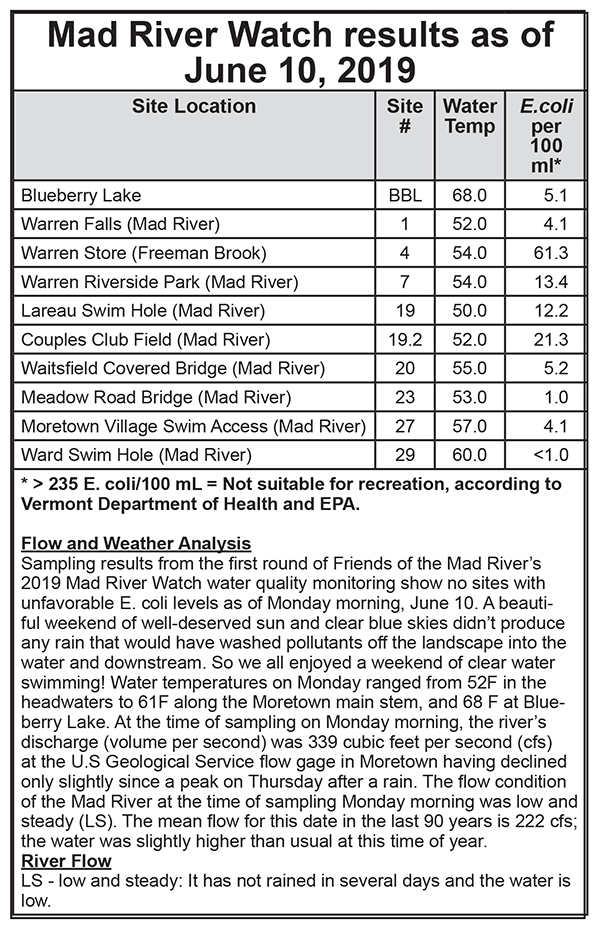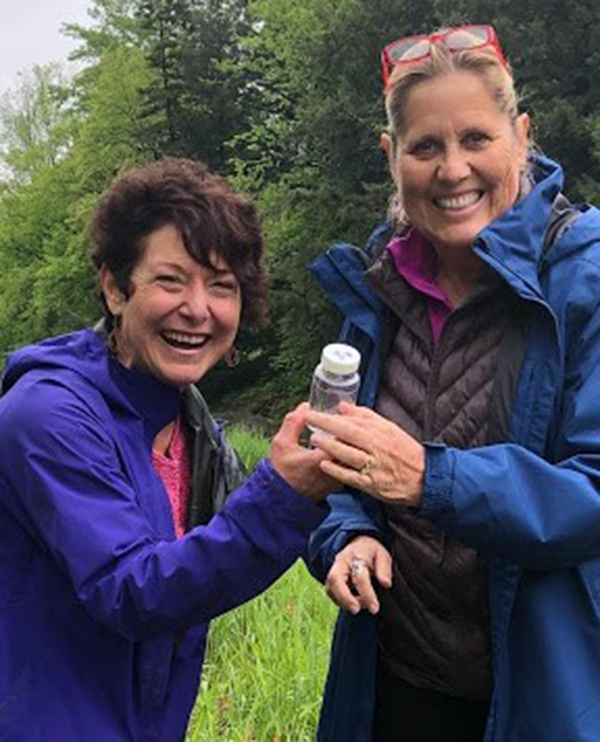Over the weekend, 19 community members geared up to help the rest of the Mad River Valley enjoy the 2019 swimming season. Friends of the Mad River (FMR) has run its volunteer-driven Mad River Watch (MRW) water quality monitoring program since 1985 to get a sense of the watershed’s overall health, provide public health information to river users and identify areas needing improvement. Monday, June 10, was the first of six 2019 sampling dates – with one every other week from June through August.
Sampling results from the first round of FMR’s 2019 Mad River Watch water quality monitoring show no sites with unfavorable E. coli levels as of Monday morning. A beautiful weekend of well-deserved sun and clear, blue skies didn't produce any rain that would have washed pollutants off the landscape, into the water and downstream. So, The Valley enjoyed a weekend of safe, crystal-clear water swimming. Water temperatures on Monday ranged from 52 F in the headwaters to 61 F along the Moretown main stem and 68 F at Blueberry Lake.
At the time of sampling on Monday morning, the river's discharge (volume per second) was 339 cubic feet per second (cfs) at the U.S. Geological Service flow gage in Moretown, having declined only slightly since a peak last Thursday after a rain. The flow condition of the Mad River at the time of sampling Monday morning was low and steady (LS). The mean flow for this date over the last 90 years is 222 cfs; the water was slightly higher than usual at this time of year.
Remember that rains can cause E. coli levels to fluctuate, even on a daily basis, as water carrying pathogens moves down the watershed. FMR’s E. coli sampling results are only a snapshot in time intended to give people a sense of the conditions that lead to high pathogen levels in the water so they can be informed.
“You are your best protector – use common sense and don't swim for several days after a rain,” said Friends of the Mad River executive director Corrie Miller.
It is estimated that at the level of 235 colonies E. coli per 100 mL water, approximately eight out of every 1,000 swimmers are likely to contract a waterborne illness related to fecal contamination.
A TEAM EFFORT
The 2019 program welcomed four new volunteers – Rick Hungerford, Ruth Lacey, Chris Shaw and Steve Willis. The program also said goodbye to three longtime volunteers. Paula Baldwin returns for her fourth year as MRW coordinator.
“Paula and I are so honored to welcome four energetic new volunteers and welcome back 14 steadfast veterans,” said Miller. “At the same time, we’re deeply grateful for the enduring enthusiasm and dedication Annie Macmillan, Hazel Macmillan, and Susy Deane breathed into Mad River Watch through their volunteer years and we wish them well in their next adventures!”
As part of the Mad River Watch program, community volunteers collect samples of water on six occasions throughout the summer from about three dozen river and tributary sites. Then, FMR’s lab and Vermont’s Agriculture and Environmental Laboratory (VAEL) analyze the samples’ bacteria and nutrient levels. FMR submits the data to The Valley Reporter and posts it on its Facebook and websites and on signs at 10 popular swim holes across The Valley so that people have information to make their own recreational health decisions. In addition to E. coli data, FMR posts total phosphorus and nitrogen data on its website at summer’s end when received back from the state lab. Over the decades, FMR has used Mad River Watch data to guide many successful cleanup efforts.
This week’s volunteers include Charlie Baldwin, Sally Boudreau, Annie and Jula Fender, Rick Hungerford, Ruth and Steve Lacey, Joel Rhodes, Susanne and George Schaefer, Chris Shaw, Michael Ware, Julie and Ingrid Westervelt and Steve Willis.
“The river connects our Mad River Valley community and its clean water takes us all,” said Miller. “Thanks to the Mad River Watch volunteers for all they do, to the landowners who give us access to important sampling spots and to community members who carefully steward their land.”
For more information about E. coli and the Mad River Watch program visit www.FriendsoftheMadRiver.org.








